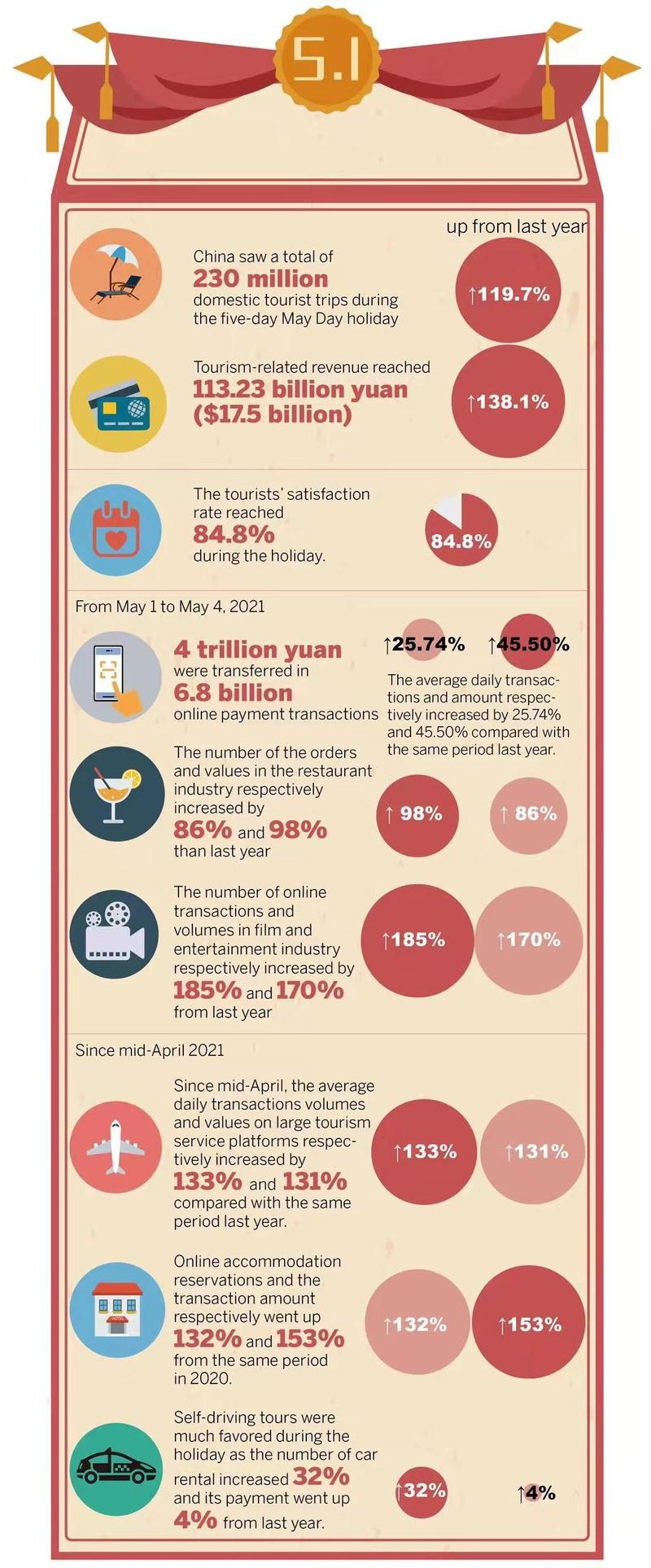Spending rose, car rentals soared and highly rated hotels did brisk business
 Passengers run to catch a train at Nanjing Railway Station, in the capital of Jiangsu province, on Wednesday. Over 17.2 million tourists were expected to return home by rail that day, the end of the five-day May Day holiday. (YANG BO / CHINA NEWS SERVICES)
Passengers run to catch a train at Nanjing Railway Station, in the capital of Jiangsu province, on Wednesday. Over 17.2 million tourists were expected to return home by rail that day, the end of the five-day May Day holiday. (YANG BO / CHINA NEWS SERVICES)
The just-ended May Day holiday has provided a robust recovery to the tourism market, boosting confidence in its future after the big shocks caused by the novel coronavirus pandemic.
Some 230 million domestic trips were made over the five-day holiday from Saturday to Wednesday, marking a year-on-year rise of 119.7 percent, according to Ministry of Culture and Tourism estimates released on Wednesday.
Trips were 103.2 percent higher than in the year before the pandemic, in 2019, the ministry said.
Also, tourism-related revenue over the break exceeded 113 billion yuan (US$17.5 billion), up 138.1 percent year-on-year, reaching 77 percent of the level before the pandemic.
Travel agencies also reported favorable figures from holiday business.
Some 230 million domestic trips were made over the five-day holiday from Saturday to Wednesday, marking a year-on-year rise of 119.7 percent, according to Ministry of Culture and Tourism estimates released on Wednesday
ALSO READ: Keeping watch for tourism’s comeback
Trip.com Group, an online travel services provider, said orders placed on its platform for the holiday rose 270 percent year-on-year and were 30 percent higher than the same period in 2019.
The company said that though ministry officials had ordered attractions nationwide to strictly control the number of visitors during the holiday by requiring customers to make reservations, it did not dampen vacationers' passion for traveling.
Trip.com said that at its platform, single-day orders for attraction tickets during the break reached up to five times that recorded on the same days in 2019.
The most popular ways of getting away also changed, travel agencies reported. Trip.com said that thanks to the toll-free policy on highways nationwide, driving surged, as did car rentals.
Car rentals over the holiday reached a single-day peak of 330 percent over the same period in 2019.
Sales of airline tickets and highly rated hotels also saw a surge over the break. Qunar, another online travel agency, said reservations of airline tickets on its platform for the holiday rose by 30 percent from 2019 and hotel reservations were up by 40 percent.

It said that travelers also spent more over the holiday, with average expenses of about 1,713 yuan reaching a record high compared with same holiday in previous years.
READ MORE: Tourism to stoke holiday consumption
Lan Xiang, Qunar's director of big data, said that the tourism market's performance exceeded even the optimistic forecasts of industry insiders.
Lan said the trends showed that "people's desire for travel has not being hampered by fear of the coronavirus pandemic, but instead has been stimulated after they had stayed at home for a rather long time", he said. "It's a triumph for the whole industry."
In addition to traditional popular attractions such as Sanya in Hainan province and the Palace Museum in Beijing, destinations famous for "red tourism" also were favored by holiday travelers.
Online travel agency Tuniu said it received numerous orders for tour packages to "red tourism "attractions, even two or three months ahead of the May Day holiday, motivated by the 100th anniversary of the Communist Party of China's founding this year.
Zou Qingling, CEO of the Lvmama online travel agency, said, "Topics related to the Party's approaching 100th anniversary on July 1 have gone viral online recently, bringing more attention to these attractions."
Tian'anmen Square in Beijing, Shaoshan in Hunan province and Deng Xiaoping's hometown of Guang'an in Sichuan province were the top three most popular "red tourism" attractions during the holiday, according to a report by Lvmama released on Wednesday.


